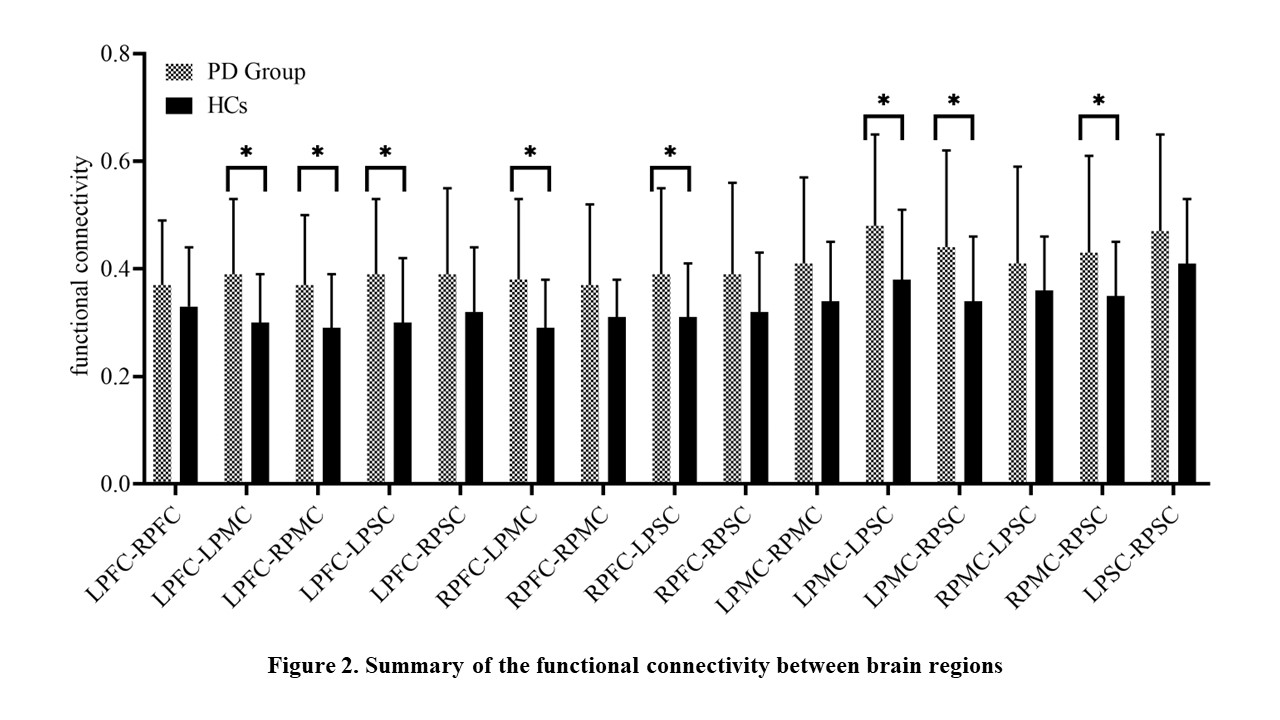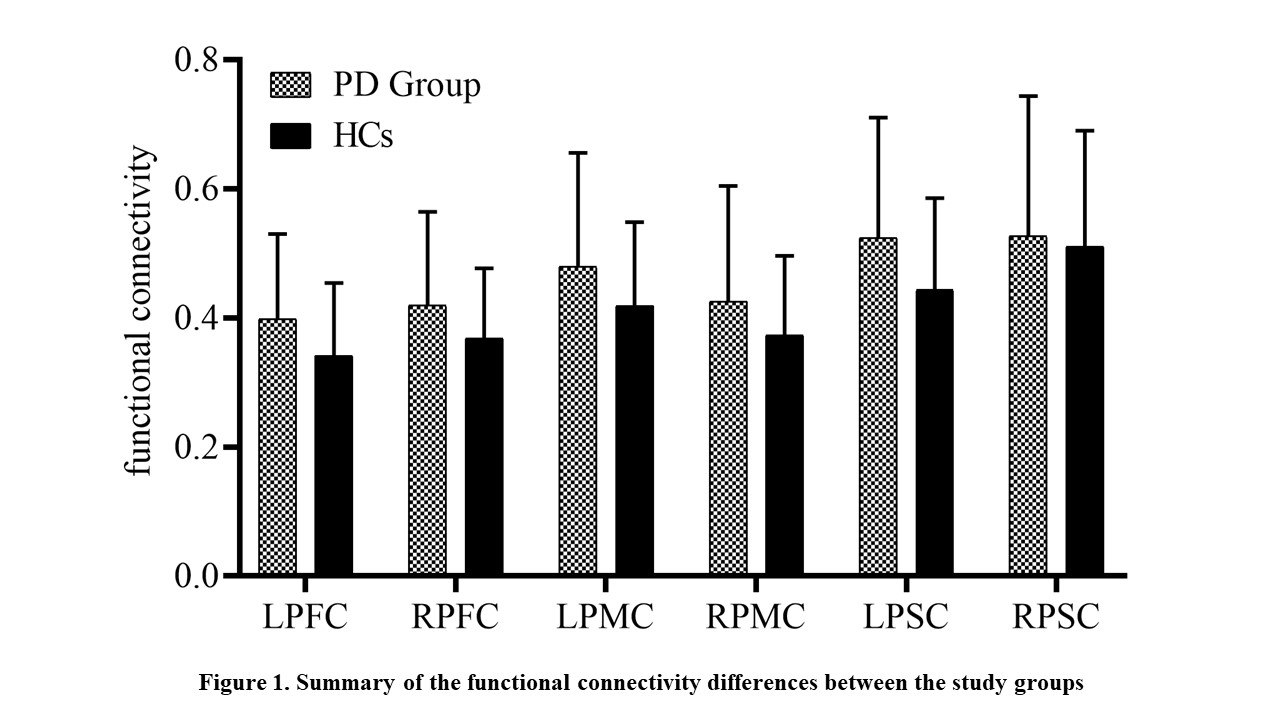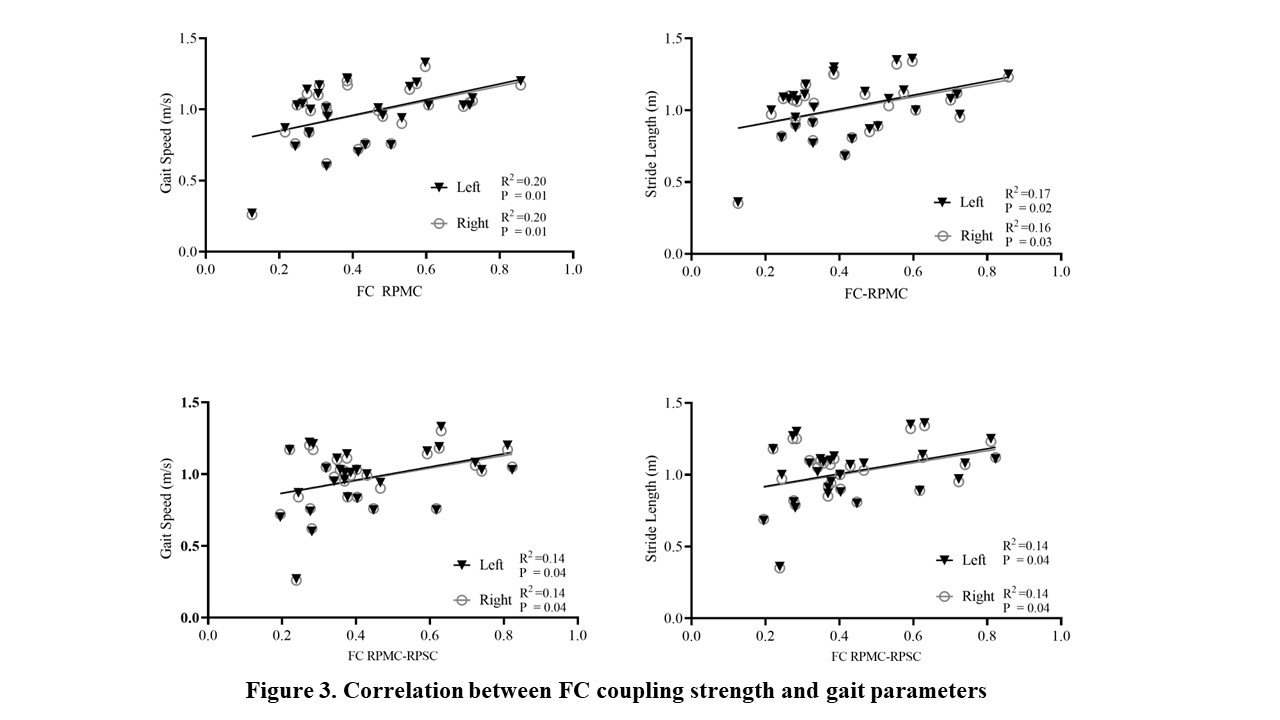Category: Parkinson's Disease: Neuroimaging
Objective: To compare the functional connectivity of PFC, PMC, and PSC regions during walking between individuals with Parkinson’s disease and healthy controls.
Background: Gait disturbances significantly impact the mobility and quality of life of individuals with Parkinson’s disease (PD). This study aims to delve into the cortical mechanisms underlying gait disorders in Parkinson’s disease, specifically focusing on the prefrontal cortex (PFC), premotor cortex (PMC), and primary somatosensory cortex (PSC).
Method: The study included 30 individuals with PD (mean age 62.40 ± 7.16 years) and 22 healthy older adults (mean age 60.95 ± 6.34 years). All participants performed a walking task, and a mobile functional near-infrared spectroscopy system was employed to evaluate cortical activation and assess functional connectivity within and between the PFC, PMC, and PSC.
Results: The findings indicate that individuals with PD in the off-state exhibit decreased walking speed and shorter stride length. No discernible differences were found in functional connectivity in the bilateral PFC, PMC, and PSC during walking when compared to the control group. However, a significant increase in functional connectivity was observed between various cortical brain regions, particularly the PFC, PMC, and PSC. The results suggested a positive correlation among the functional connectivity coupling strength of the right-side PMC(RPMC), RPMC-right-side PSC(RPSC), gait speed, and stride length in individuals with PD.
Conclusion: These findings suggest that individuals with PD exhibit notable gait disturbances during the off-state, which are associated with changes in functional connectivity within specific cortical brain regions, notably the premotor cortex and the primary somatosensory cortex.
figure 1
figure 2
figure 3
References: . Allen N, Schwarzel A, Canning C. Recurrent falls in Parkinson’s disease: a systematic review. Parkinson’s disease. 2013;2013:906274.
2.Weiss D, Schoellmann A, Fox M, et al. Freezing of gait: understanding the complexity of an enigmatic phenomenon. Brain : a journal of neurology. 2020;143(1):14-30.
3.Takakusaki Kaoru,Functional Neuroanatomy for Posture and Gait Control.[J] .J Mov Disord, 2017, 10: 1-17.
4.Song Wenjing,Raza Hafiz Khuram,Lu Li et al. Functional MRI in Parkinson’s disease with freezing of gait: a systematic review of the literature.[J] .Neurol Sci, 2021, 42: 1759-1771.
5.Kim Hyejun,Fraser Sarah,Neural correlates of dual-task walking in people with central neurological disorders: a systematic review.[J] .J Neurol, 2022, 269: 2378-2402.
6.Rahman Md Asadur,Siddik Abu Bakar,Ghosh Tarun Kanti et al. A Narrative Review on Clinical Applications of fNIRS.[J] .J Digit Imaging, 2020, 33: 1167-1184.
7.Stuart Samuel,Vitorio Rodrigo,Morris Rosie et al. Cortical activity during walking and balance tasks in older adults and in people with Parkinson’s disease: A structured review.[J] .Maturitas, 2018, 113: 53-72.
8.Nieuwhof Freek,Reelick Miriam F,Maidan Inbal et al. Measuring prefrontal cortical activity during dual task walking in patients with Parkinson’s disease: feasibility of using a new portable fNIRS device.[J] .Pilot Feasibility Stud, 2016, 2: 59.
9.Maidan I,Rosenberg-Katz K,Jacob Y et al. Altered brain activation in complex walking conditions in patients with Parkinson’s disease.[J] .Parkinsonism Relat Disord, 2016, 25: 91-6.
10.Tachibana A, Noah JA, Bronner S, et al. Activation of dorsolateral prefrontal cortex in a dual neuropsychological screening test: an fMRI approach. Behav Brain Funct. 2012;8:26. doi:10.1186/1744-9081-8-26.
1.Nutt JG, Horak FB, Bloem BR. Milestones in gait, balance, and falling. Mov Disord. 2011;26(6):1166-1174.
2. Maidan Inbal,Bernad-Elazari Hagar,Gazit Eran et al. Changes in oxygenated hemoglobin link freezing of gait to frontal activation in patients with Parkinson disease: an fNIRS study of transient motor-cognitive failures.[J] .J Neurol, 2015, 262: 899-908.
3.Maidan Inbal,Nieuwhof Freek,Bernad-Elazari Hagar et al. The Role of the Frontal Lobe in Complex Walking Among Patients With Parkinson’s Disease and Healthy Older Adults: An fNIRS Study.[J] .Neurorehabil Neural Repair, 2016, 30: 963-971.
4.Orcioli-Silva Diego,Vitório Rodrigo,Beretta Victor Spiandor et al. Is Cortical Activation During Walking Different Between Parkinson’s Disease Motor Subtypes?[J] .J Gerontol A Biol Sci Med Sci, 2021, 76: 561-567.
5.Vitorio Rodrigo,Stuart Samuel,Mancini Martina,Executive Control of Walking in People With Parkinson’s Disease With Freezing of Gait.[J] .Neurorehabil Neural Repair, 2020, 34: 1138-1149.
6.Nieuwhof Freek,Bloem Bastiaan R,Reelick Miriam F et al. Impaired dual tasking in Parkinson’s disease is associated with reduced focusing of cortico-striatal activity.[J] .Brain, 2017, 140: 1384-1398.
17.Nachev Parashkev,Kennard Christopher,Husain Masud,Functional role of the supplementary and pre-supplementary motor areas.[J] .Nat Rev Neurosci, 2008, 9: 856-69.
18.Palomar Francisco J,Díaz-Corrales Francisco,Carrillo Fatima et al. Sensory perception changes induced by transcranial magnetic stimulation over the primary somatosensory cortex in Parkinson’s disease.[J] .Mov Disord, 2011, 26: 2058-64.
19.Orcioli-Silva Diego,Vitório Rodrigo,Nóbrega-Sousa Priscila et al. Cortical Activity Underlying Gait Improvements Achieved With Dopaminergic Medication During Usual Walking and Obstacle Avoidance in Parkinson Disease.[J] .Neurorehabil Neural Repair, 2021, 35: 406-418.
20.Friston Karl J,Functional and effective connectivity: a review.[J] .Brain Connect, 2011, 1: 13-36.
21.Yu Ningbo,Liang Siquan,Lu Jiewei et al. Quantified assessment of deep brain stimulation on Parkinson’s patients with task fNIRS measurements and functional connectivity analysis: a pilot study.[J] .Chin Neurosurg J, 2021, 7: 34.
22.Postuma Ronald B,Berg Daniela,Stern Matthew et al. MDS clinical diagnostic criteria for Parkinson’s disease.[J] .Mov Disord, 2015, 30: 1591-601.
23.Vitorio R,Stuart S,Rochester L et al. fNIRS response during walking – Artefact or cortical activity? A systematic review.[J] .Neurosci Biobehav Rev, 2017, 83: 160-172.
24.Scholkmann Felix,Kleiser Stefan,Metz Andreas Jaakko et al. A review on continuous wave functional near-infrared spectroscopy and imaging instrumentation and methodology.[J] .Neuroimage, 2014, null: 6-27.
25.Stuart Samuel,Belluscio Valeria,Quinn Joseph F et al. Pre-frontal Cortical Activity During Walking and Turning Is Reliable and Differentiates Across Young, Older Adults and People With Parkinson’s Disease.[J] .Front Neurol, 2019, 10: 536.
26.Orcioli-Silva Diego,Vitório Rodrigo,Nóbrega-Sousa Priscila et al. Levodopa Facilitates Prefrontal Cortex Activation During Dual Task Walking in Parkinson Disease.[J] .Neurorehabil Neural Repair, 2020, 34: 589-599.
27.Dagan Moria,Herman Talia,Bernad-Elazari Hagar et al. Dopaminergic therapy and prefrontal activation during walking in individuals with Parkinson’s disease: does the levodopa overdose hypothesis extend to gait?[J] .J Neurol, 2021, 268: 658-668.
28.Foki Thomas,Pirker Walter,Geißler Alexander et al. Finger dexterity deficits in Parkinson’s disease and somatosensory cortical dysfunction.[J] .Parkinsonism Relat Disord, 2015, 21: 259-65.
29.Weder B,Azari N P,Knorr U et al. Disturbed functional brain interactions underlying deficient tactile object discrimination in Parkinson’s disease.[J] .Hum Brain Mapp, 2000, 11: 131-45.
30.Vecchio Fabrizio,Pappalettera Chiara,Miraglia Francesca et al. Graph Theory on Brain Cortical Sources in Parkinson’s Disease: The Analysis of ‘Small World’ Organization from EEG.[J] .Sensors (Basel), 2021, 21: undefined.
31.Conti Matteo,Guerra Andrea,Pierantozzi Mariangela et al. Band-Specific Altered Cortical Connectivity in Early Parkinson’s Disease and its Clinical Correlates.[J] .Mov Disord, 2023, 38: 2197-2208.
32.Liu Yan-Ci,Yang Yea-Ru,Yeh Nai-Chen et al. Multiarea Brain Activation and Gait Deterioration During a Cognitive and Motor Dual Task in Individuals With Parkinson Disease.[J] .J Neurol Phys Ther, 2022, 46: 260-269.
33.Fukuyama H,Ouchi Y,Matsuzaki S et al. Brain functional activity during gait in normal subjects: a SPECT study.[J] .Neurosci Lett, 1997, 228: 183-6.
34.Wei Xuan,Wang Zheng,Zhang Mingkai et al. Brain Surface Area Alterations Correlate With Gait Impairments in Parkinson’s Disease.[J] .Front Aging Neurosci, 2022, 14: 806026.
35.Jia Xiuqin,Fan Wentao,Wang Zhijiang et al. Progressive Prefrontal Cortex Dysfunction in Parkinson’s Disease With Probable REM Sleep Behavior Disorder: A 3-Year Longitudinal Study.[J] .Front Aging Neurosci, 2021, 13: 750767.
36.Wu Tao,Hallett Mark,A functional MRI study of automatic movements in patients with Parkinson’s disease.[J] .Brain, 2005, 128: 2250-9.
37.Guo Yao,Yang Jianxin,Liu Yuxuan et al. Detection and assessment of Parkinson’s disease based on gait analysis: A survey.[J] .Front Aging Neurosci, 2022, 14: 916971.
38.Mitchell Trina,Conradsson David,Paquette Caroline,Gait and trunk kinematics during prolonged turning in Parkinson’s disease with freezing of gait.[J] .Parkinsonism Relat Disord, 2019, 64: 188-193.
39.Gilat Moran,Bell Peter T,Ehgoetz Martens Kaylena A et al. Dopamine depletion impairs gait automaticity by altering cortico-striatal and cerebellar processing in Parkinson’s disease.[J] .Neuroimage, 2017, 152: 207-220.
To cite this abstract in AMA style:
ZZ. Zhu, JL. Wu, NB. Yu, JD. Han, J. Wang, Y. Wang. Decrease in Walking Ability with Increased Functional Connectivity between Multiple Brain Areas in Parkinson’s Disease [abstract]. Mov Disord. 2024; 39 (suppl 1). https://www.mdsabstracts.org/abstract/decrease-in-walking-ability-with-increased-functional-connectivity-between-multiple-brain-areas-in-parkinsons-disease/. Accessed December 9, 2025.« Back to 2024 International Congress
MDS Abstracts - https://www.mdsabstracts.org/abstract/decrease-in-walking-ability-with-increased-functional-connectivity-between-multiple-brain-areas-in-parkinsons-disease/



